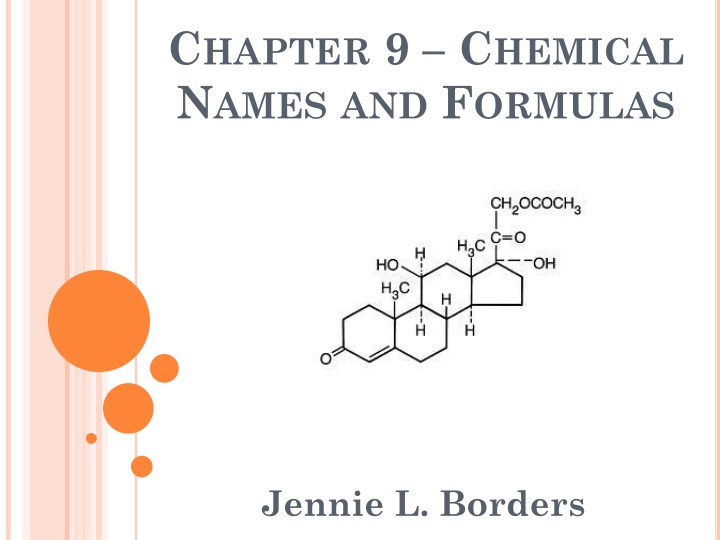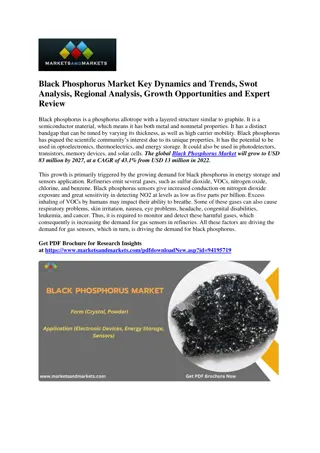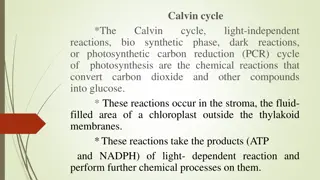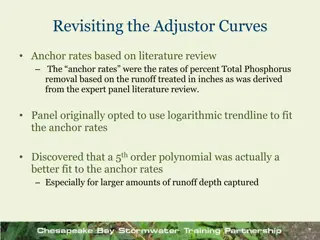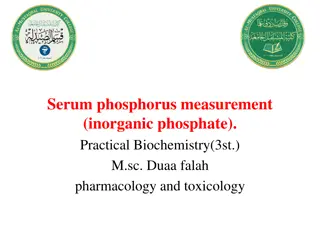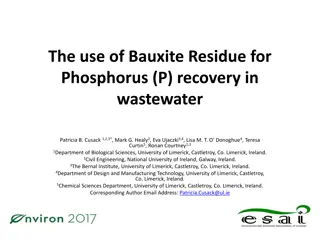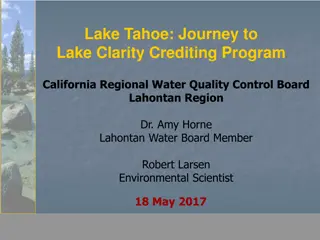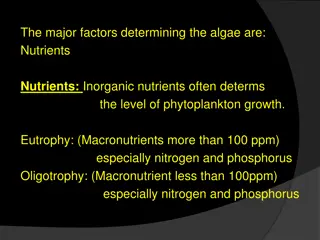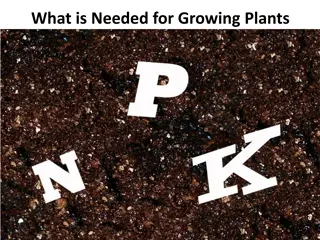Phosphorus Cycle: Processes and Impacts
Phosphorus cycle involves various stages including soil uptake by plants, consumption by animals, and return via waste and decay. It plays a crucial role in aquatic ecosystems but can lead to eutrophication when in excess. The global cycle highlights the limited atmospheric source of phosphorus and the distinction between geologic and biologically active phosphate pools.
Download Presentation

Please find below an Image/Link to download the presentation.
The content on the website is provided AS IS for your information and personal use only. It may not be sold, licensed, or shared on other websites without obtaining consent from the author.If you encounter any issues during the download, it is possible that the publisher has removed the file from their server.
You are allowed to download the files provided on this website for personal or commercial use, subject to the condition that they are used lawfully. All files are the property of their respective owners.
The content on the website is provided AS IS for your information and personal use only. It may not be sold, licensed, or shared on other websites without obtaining consent from the author.
E N D
Presentation Transcript
CHAPTER 9 CHEMICAL NAMES AND FORMULAS Jennie L. Borders
SECTION 9.1 REGULAR METALS REVIEW The regular metals include Group 1 (except H) and 2 and aluminum. When naming a compound that starts with a regular metal, name the first element and add ide to the second element (except for polyatomic ions). When writing the formula, remember to balance charges.
SAMPLE PROBLEM Write the name or formula for the following: AlBr3 Aluminum bromide Sodium sulfate Na2SO4
PRACTICE PROBLEMS Write the name or formula for the following: LiNO3 Lithium nitrate SrCl2 Strontium chloride Barium oxide BaO Magnesium phosphate Mg3(PO4)2
SECTION 9.2 TRANSITION METALS REVIEW The transition metals are in Groups 3 12 and the triangle. When naming compounds that start with a transition metal, name the first element, add a roman numeral for the charge, and add ide to the second element (except for polyatomic ions). When writing the formula, remember to balance charges.
OLD NAMESFOR TRANSITION METALS Remember that for the old naming system for transition metals, the ic ending means the higher charge and the ous ending means the lower charge. Fe3+ Fe2+ Cu2+ Cu+ Co3+ Co2+ Sn4+ Sn2+ Pb4+ Pb2+ Hg2+ Hg22+ Ion Old Name ferric ferrous cupric cuprous cobaltic cobaltous stannic stannous plumbic plumbous mercuric mercurous
SAMPLE PROBLEM Write the name or formula for the following: Fe2O3 Iron (III) oxide Cupric sulfite CuSO3
PRACTICE PROBLEM Write the name or formula for the following: Zinc (II) permanganate Zn(MnO4)2 Cu2O (old name) Cuprous oxide
SECTION 9.3 NONMETALS REVIEW The nonmetals are located to the right of the stair-step line on the periodic table. When naming compounds that start with nonmetals, use prefixes to indicate the number of atoms (except when the first element has 1 atom) and add ide to the second element. When writing the formula do NOT balance charges, use the prefixes to find the subscripts.
SAMPLE PROBLEM Write the name and formula for the following: N2O Dinitrogen monoxide Diphosphorus pentoxide P2O5
PRACTICE PROBLEMS Write the name and formula for the following. CO Carbon monoxide CCl4 Carbon tetrachloride Nitrogen trihydride NH3 Phosphorous trichloride PCl3
SECTION 9.4 NAMINGAND WRITING FORMULASFOR ACIDSAND BASES An acid is a compound that produces H+ ions when it dissolves in water. The formula for an acid normally starts with and H. When naming acids, you should first determine whether or not the acid contains oxygen.
ACIDSTHATDONOT CONTAIN OXYGEN If the acid does not contain oxygen, then you add the prefix hydro- and suffix is ic. Also add acid at the end. Ex: HCl = hydrochloric acid
SAMPLE PROBLEM Write the names of the following acids: HF Hydrofluoric acid HCN Hydrocyanic acid
PRACTICE PROBLEM Write the names for the following acids: HBr Hydrobromic acid Hydroiodic acid HI
ACIDSTHATDOCONTAIN OXYGEN When an acid does contain oxygen, you must determine whether its polyatomic ion ends in ate or ite. If the polyatomic ion ends in ate, then we change the ending to ic. Ex: HNO3 = NO3- = nitrate = nitric acid If the polyatomic ion ends in ite, then we change the ending to ous. Ex: HNO2 = NO2- = nitrite = nitrous acid
SAMPLE PROBLEMS Write the names of the following acids: Sulfuric acid H2SO4 H3PO4 Phosphoric acid H2SO3 Sulfurous acid
PRACTICE PROBLEMS Write the names for the following acids. H2CO3 Carbonic acid H3PO3 Phosphorous acid HClO2 Chlorous acid
WRITINGTHE FORMULASFOR ACIDS When writing the formula for an acid always start with H even if it is not in the name. Remember to balance the charges. The ending ic means that the polyatomic ion ends in ate. The ending ous means that the polyatomic ion ends in ite.
SAMPLE PROBLEM Write the formula for the following acids. Hydrosulfuric acid H2S Hypochorous acid HClO Acetic acid HC2H3O2
PRACTICE PROBLEMS Write the formula for the following acids. Perchloric acid HClO4 Chromic acid H2CrO4 H2C2O4 Oxalic acid
WRITINGTHE NAMESAND FORMULAS FOR BASES A base is a compound that produces OH- in water. When naming a base, you name it like any other compound that starts with a regular or transition metal. Ex: NaOH = sodium hydroxide When writing the formula for a base, remember to balance charges. Ex: magnesium hydroxide = Mg(OH)2
SECTION 9.4 ASSESSMENT 1. How are the formulas for acids determined? 2. How are bases named? 3. Give the name of HMnO4. 4. Give the names of these bases. a. LiOH b. Pb(OH)2 c. Al(OH)3 5. Identify each compound as an acid or a base. a. Ba(OH)2 b. HClO4 c. KOH
SECTION 9.4 ASSESSMENT 6. Write the formula for the following compounds. a. carbonic acid b. sulfurous acid c. iron (III) hydroxide
THE END
